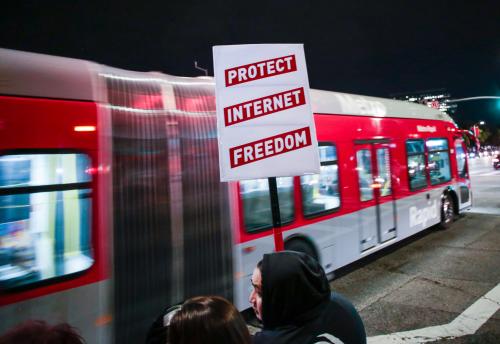The Antitrust Division of the Justice Department appears to have put its thumb on the scale in the ongoing battle between the Walt Disney Company and Comcast over the assets of 21st Century Fox. On June 27, the division approved the transfer to Disney (with conditions) despite the fact Comcast was still bidding.
Disney had previously argued to the Fox board of directors that their merger faced less regulatory risk than Comcast’s. The Disney-Fox combination would produce a larger horizontally-integrated company, and one that would typically pose the greater risk. But Disney argued that because Comcast is also an internet service provider (ISP), the government would have heightened concerns based on the ability of that network to discriminate among users.
The problem with this argument is that the Trump administration has already taken the “ISPs can discriminate” assertion off the table. When the Trump Federal Communications Commission (FCC) repealed the Open Internet Rule (“net neutrality”) they took the position that ISPs will not discriminate, and if they do, the Federal Trade Commission (FTC) can respond. As a result, the Trump Justice Department did not even raise the ISP integration-means-discrimination issue in the preceding AT&T-Time Warner case.
Notwithstanding the department’s rush to judgement, its inability to make the ISP discrimination case mitigates the alleged regulatory risk posed by the Comcast offer. Fealty to the Trump doctrine that ISPs will not discriminate denied the Antitrust Division a powerful argument in the AT&T-Time Warner case; it should have the same effect in similar cases going forward.
In the AT&T-Time Warner case, the division focused principally on the effect of combining Time Warner’s video content with AT&T’s ownership of DirecTV, a satellite video provider losing subscribers to internet services. The department could not raise the stronger argument about the threat posed by combining AT&T’s wired and wireless internet networks with the content they distribute.
One could only feel sorry for the Justice Department attorneys kept from making a stronger case because of the Trump administration’s policy. But if discrimination risk did not apply to the AT&T transaction, neither should it apply to Comcast’s vertical integration.
The fact that Disney’s horizontal merger with Fox would increase their control of the video market more than a Comcast-Fox vertical merger did not seem to bother the Justice Department. Why should there then be regulatory risk for Comcast? Not only do they pose less of a threat in the horizontal video market, but the combination of the AT&T decision and the repeal of the Open Internet Rules also removes the issue of discriminatory vertical integration.
Logically, the regulatory risk for Comcast is overblown. The problem is whether logic is applicable to this administration. President Trump has made no secret of who he likes in this horserace. He called to congratulate Rupert Murdoch shortly after the original Disney bid was announced. He also threatened to have the Trump FCC take away Comcast-owned NBC’s broadcast licenses because he did not like their coverage of him.
It leaves one to wonder what the real risk is. Sometimes in Washington, words whose meanings seem obvious are actually smokescreens for something else. The Justice Department should be a law enforcement agency, applying antitrust statutes outside of political or personal preferences. Let’s hope it stays that way and we aren’t left to wonder what “regulatory risk” really means.
AT&T and Comcast are donors to the Brookings Institution. The findings, interpretations, and conclusions posted in this piece are solely those of the authors and not influenced by any donation.
The Brookings Institution is committed to quality, independence, and impact.
We are supported by a diverse array of funders. In line with our values and policies, each Brookings publication represents the sole views of its author(s).








Commentary
The logic between “regulatory risk” and antitrust review of media mergers
July 11, 2018